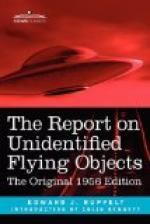CHAPTER THREE
The Classics
1948 was only one hour and twenty-five minutes old when a gentleman from Abilene, Texas, made the first UFO report of the year. What he saw, “a fan-shaped glow” in the sky, was insignificant as far as UFO reports go, but it ushered in a year that was to bring feverish activity to Project Sign.
With the Soviets practically eliminated as a UFO source, the idea of interplanetary spaceships was becoming more popular. During 1948 the people in ATIC were openly discussing the possibility of interplanetary visitors without others tapping their heads and looking smug. During 1948 the novelty of UFO’s had worn off for the press and every John and Jane Doe who saw one didn’t make the front pages as in 1947. Editors were becoming hardened, only a few of the best reports got any space. Only “The Classics” rated headlines. “The Classics” were three historic reports that were the highlights of 1948. They are called “The Classics,” a name given them by the Project Blue Book staff, because: (1) they are classic examples of how the true facts of a UFO report can be twisted and warped by some writers to prove their point, (2) they are the most highly publicized reports of this early era of the UFO’s, and (3) they “proved” to ATIC’s intelligence specialists that UFO’s were real.
The apparent lack of interest in UFO reports by the press was not a true indication of the situation. I later found out, from talking to writers, that all during 1948 the interest in UFO’s was running high. The Air Force Press Desk in the Pentagon was continually being asked what progress was being made in the UFO investigation. The answer was, “Give us time. This job can’t be done in a week.” The press respected this and was giving them time. But every writer worth his salt has contacts, those “usually reliable sources” you read about, and these contacts were talking. All during 1948 contacts in the Pentagon were telling how UFO reports were rolling in at the rate of several per day and how ATIC UFO investigation teams were flying out of Dayton to investigate them. They were telling how another Air Force investigative organization had been called in to lighten ATIC’s load and allow ATIC to concentrate on the analysis of the reports. The writers knew this was true because they had crossed paths with these men whom they had mistakenly identified as FBI agents. The FBI was never officially interested in UFO sightings. The writers’ contacts in the airline industry told about the UFO talk from V.P.’s down to the ramp boys. Dozens of good, solid, reliable, experienced airline pilots were seeing UFO’s. All of this led to one conclusion: whatever the Air Force had to say, when it was ready to talk, would be newsworthy. But the Air Force wasn’t ready to talk.
Project Sign personnel were just getting settled down to work after the New Year’s holiday when the “ghost rockets” came back to the Scandinavian countries of Europe. Air attaches in Sweden, Denmark, and Norway fired wires to ATIC telling about the reports. Wires went back asking for more information.




